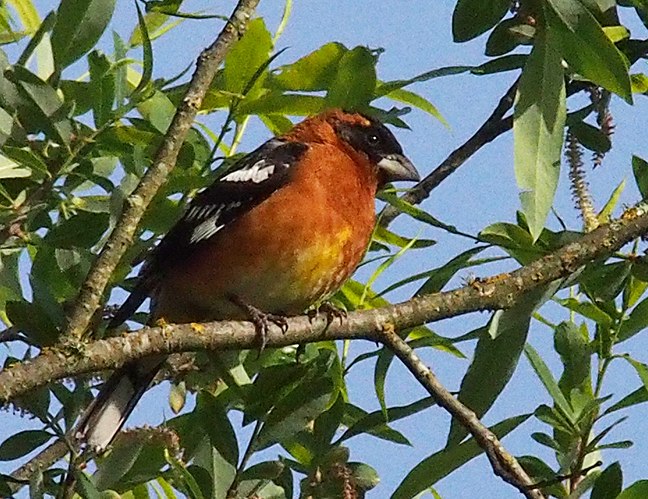A practical guide to bird watching in Sonoma County, California
(Unless otherwise indicated, all phone numbers are in the 707 area code)
A practical guide to bird watching in Sonoma County, California
(Unless otherwise indicated, all phone numbers are in the 707 area code)


One of the loudest and most obvious spring songsters in Sonoma County once you know the song. Males during breeding season tend to sit near the top of tall trees singing loudly, often seeming closer than they actually are. Females tend to skulk. Tending mostly to nest duties in the spring, they are much harder to see. Black-headed Grosbeaks start arriving in numbers in Sonoma County in early to mid-April, staying until mid- to late September, although they are perhaps most commonly noted here during the early part of the nesting season (April-May). Good places to see and hear Black-headed Grosbeak in the county include Willowside Rd. in Santa Rosa and Spring Lake, also in Santa Rosa, but common in the summer in most of the county where there is deciduous or coniferous forest, especially oak or other broadleaf woodland areas near water. In general, seems to prefer deciduous woods near open areas or water, but uncommon at the coast. Breeds throughout the county except in the extreme southern coastal areas and the densely wooded extreme northwest. Usually solitary or, during nesting season, in pairs. Eats insects, berries, seeds. Our only common Grosbeak (Evening Grosbeak (Coccothraustes vespertinus) is a sporadic, uncommon visitor, usually in the winter, Rose-breasted Grosbeak (Pheucticus ludovicianus) is accidental in Sonoma County, Blue Grosbeak (Passerina caerulea) even more unusual here).
The male is easily recognized by its black wings with prominent white wing bars contrasting against a mostly rusty orange body (upper breast, flanks, nape, and rump all are orange). The orange extends to the back of the neck. The head, like the wings, is black, giving the bird its common and Latin names. The amount of black on the head is somewhat variable, but the cheek, face, and crown are always black. Although the belly often simply looks pale in the field, a good view shows it’s actually yellow. White at vent and under the tail. White outer tail feathers and white wing patches conspicuous in flight. Wing linings in flight yellowish (in both sexes). Note also the massive bill. Upper mandible usually darker than the lower. Females have the same heavy bill and big-headed, thick-necked silhouette, but they are quite differently colored, being an overall streaky brown with much-attenuated white wing bars (lacking the male’s white wing patches in flight). Breast warmer in color than the rest of the bird, but quite dull compared to the male. Most obvious feature of the female is its striped head (dark crown, pale above and in front of the eye, dark cheek, white under the cheek—see photo below). First-year males resemble females but with richer color on the breast.
English synonyms: Rocky Mountain Grosbeak (not used in Sonoma County)
Black-headed Grosbeak in other languages—German: Schwarzkopf-Kernkancker; Spanish: Picogordo Tigrillo, Picogrueso Cabecinegro, Picogrueso tigrillo, Piquigrueso de Cabeza Negra, Picogrueso cabecinegro; French: Cardinal à tête noire, Casse-graine à tête noire, Gros-bec à tête noire; Italian: Beccogrosso testanera; Dutch: Zwartkopbisschop, Zwartkopkardinaal; Russian: Черноголовый дубоносовый кардинал;
Japanese: チャバライカル (chabaraikaru); Chinese: 黑头白斑翅雀
(Language information from Avibase, Birds of Europe (Mullarney et al, Princeton Field Guide Series), and Birds of Asia (Mark Brazil, Princeton Field Guide Series).
Further reading:
Bolander and Parmeter, Birds of Sonoma County California, rev. ed., 2000, p. 118
Brinkley, National Wildlife Federation Field Guide to Birds of North America, 2007, p. 438
Burridge, ed., Sonoma County Breeding Bird Atlas, 1995, p. 155
Dunn and Alderfer, eds., National Geographic Field Guide to the Birds of North America, 5th ed., 2006, p. 436
Dunn and Alderfer, eds., National Geographic Field Guide to the Birds of North America, 6th ed., 2011, p. 494
Dunne, Pete Dunne’s Essential Field Guide Companion, 2006, pp. 634-635
Ehrlich, Dobkin, and Wheye, The Birder's Handbook, paperback edition, 1988, p. 554
Fix and Bezener, Birds of Northern California, 2000, p. 344
Floyd, Smithsonian Field Guide to the Birds of North America, 2008, p. 447
Kaufman, Field Guide to Birds of North America, 2000, p. 376
Kaufman, Field Guide to Advanced Birding, 2011, pp. 11, 19, 124
Lukas, Bay Area Birds: From Sonoma County to Monterey Bay, 2012, pp. 261-263
Parmeter and Wight, Birds of Sonoma County California, Update (2000-2010), 2012, p. 71
Peterson, Birds of Eastern and Central North America, 5th ed., 2002, p. 286
Peterson, Field Guide to Birds of Western North America, 4th ed., 2010, p. 346
Peterson, Western Birds, 3rd ed., 1990, p. 336
Sibley, Field Guide to Birds of Western North America,1st ed., 2003, p. 400
Stokes, Stokes Field Guide to the Birds of North America, 1st ed., 2010, p. 707
Vuilleumier, American Museum of Natural History, Birds of North America: Western Region, 2011, p. 415
Voice: Cornell Lab of Ornithology: All About Birds--Black-headed Grosbeak
© Colin Talcroft, 2009-2018
Unless noted, all photos by the author. If you would like to use one of my images, please ask for permission for non-commercial use with proper credit or commercial use with proper compensation.
Black-headed Grosbeak
Pheucticus melanocephalus
Black-headed Grosbeak (Male), Willowside Rd., Santa Rosa, April 15, 2017
2000-2017 Sonoma County data. Graph provided by eBird (www.ebird.org), generated April 15, 2017
EBird reported occurrence in Sonoma County



Black-headed Grosbeak (Female), Duncans Mills, May 16, 2012
